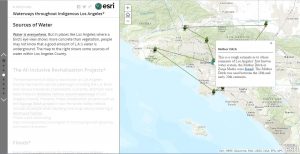A collaboration between the Digital Humanities department, faculty, and students at UCLA and community researchers and leaders, Mapping Indigenous Los Angeles is a website that makes visible and interactive through maps, images, relevant documents, videos and other visualizations the many Indigenous histories of Southern California including those of the Gabrielino Tongva, the Latin American diaspora, and Pacific Islander communities— people that have been displaced by processes such as neo-liberal economic policies, and intersecting colonial histories— that are often obscured yet deeply rooted in Los Angeles history, culture and geography.
Sources: Because this project relies on story-telling through interactive digital maps, and community-based research collaboration, it draws from multiple sources across the digital and physical landscape. It lists teaching and reading materials such as texts ranging from federal documents to oral history projects as well as interviews with community leaders. Videos, links within the text, scanned artworks, and other sources are used consistently throughout the available and interactive maps for Los Angeles waterways, American Indian Health and Education Resources and Latin American Indigenous diaspora.
Processes: The primary processing tool used is the ESRI Story Maps program through Arcgis, which is a geographic information mapping system available online for public use.
Presentations: Each storymap includes accompanying text embedded with links to documents and terms referenced, further expanding the field of information made immediately web-accessible. One of the websites featured links available on the dashboard is “Create your own storymap” where the hugely collaborative element of this project is encouraged all the more.

I appreciate the fact that your blog post is very organized, with a clear introduction, then followed by labeled sources, processes, and presentations. I can clearly tell you’ve taken a good look at the website. Perhaps, playing out with the tools, for example by highlight sources processes and presentation would make the appearance of the post much more aesthetically pleasing. Also, perhaps another map with a more concrete connection to your piece may make the blog even better. In addition, stating why they chose the way they presented the sources would greatly improve the piece.
Very thorough description of the project! I like how you organized this blog post in order to convey the three main points detailing the sources, processes, and presentation. Your breakdown is logical and well thought out. Thanks for sharing!
I thought this blog was so well explained, when reading your post you really understand what the directions mean when were being asked processes, sources and presentation. This post drew my attention today especially because I am taking a Native American Class, and we focused on the displacement of tribes within the Southern California region. This website would be super resourceful if you wanted to track a certain tribal communities, and has an extremely clean and easy to use navigating. Super clear and nicely worded post!
Great blog post! I liked how you organized it by first providing relevant background info on what the site was about and then were able to breakdown the 3 key takeaways of what made this specific site tick in regards to it’s Sources, Processes, and Presentations. Some things to make look towards for a further analysis of a similar site would probably be to maybe utilize more visualizations to help further your background research into the site. That way the reader has a better idea of whats being discussed.
Great post! Especially enjoyed your thorough introduction to the project – explaining why these projects are necessary, etc. I also liked how you linked a community’s investment in story-telling with the format of the online project, explaining how community-based research is articulated across an online and physical landscape.
Isn’t this a cool project? I think the most interesting and powerful aspect of it is the careful way that the scholars ensured that indigenous people themselves were involved in project from the beginning.
I thought your post was great and organized in a way which made it easy to follow and understand. I did my blog on this website also and found your blog to be helpful in understanding it better. I enjoyed exploring this site and checking out all of the story maps of indigenous cultures in LA.